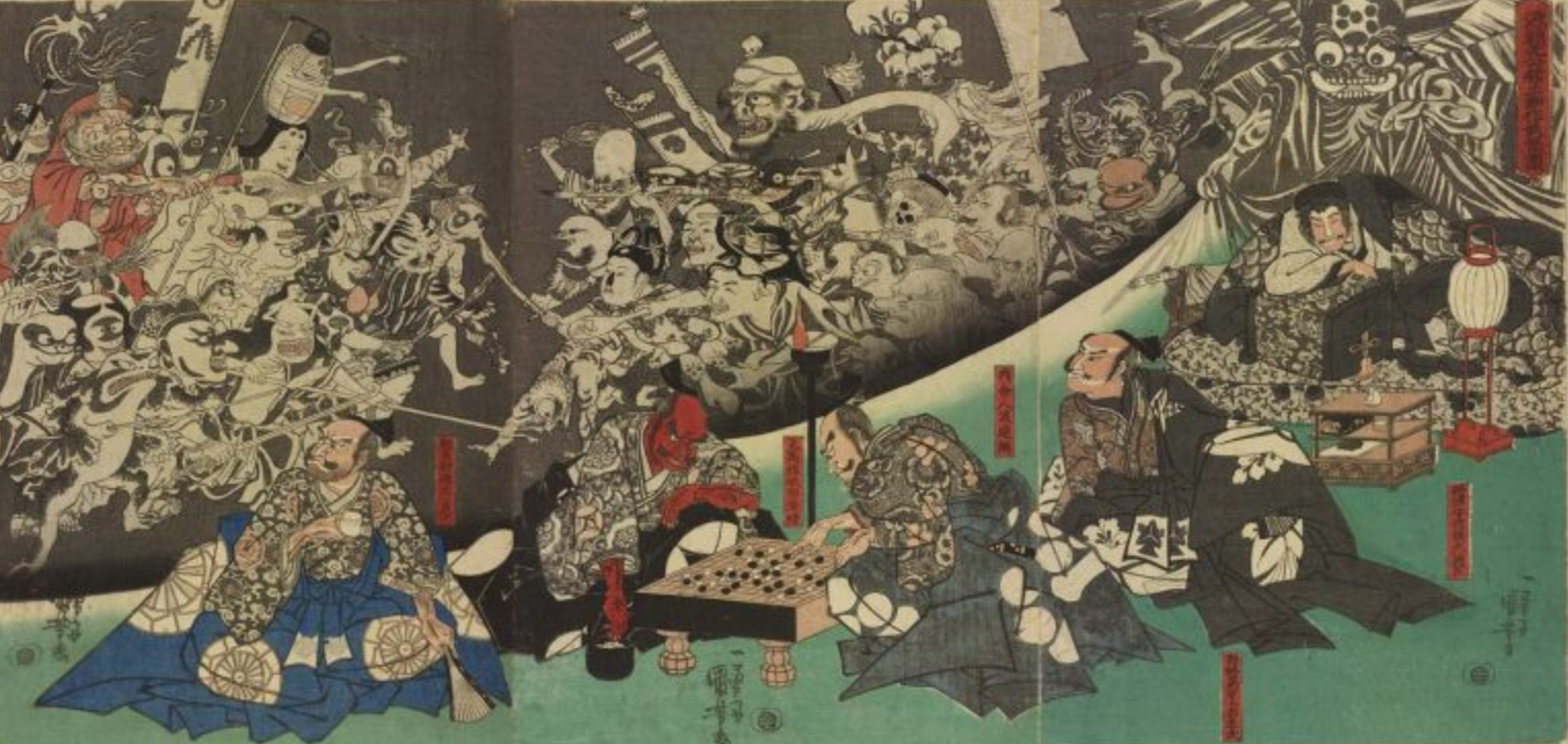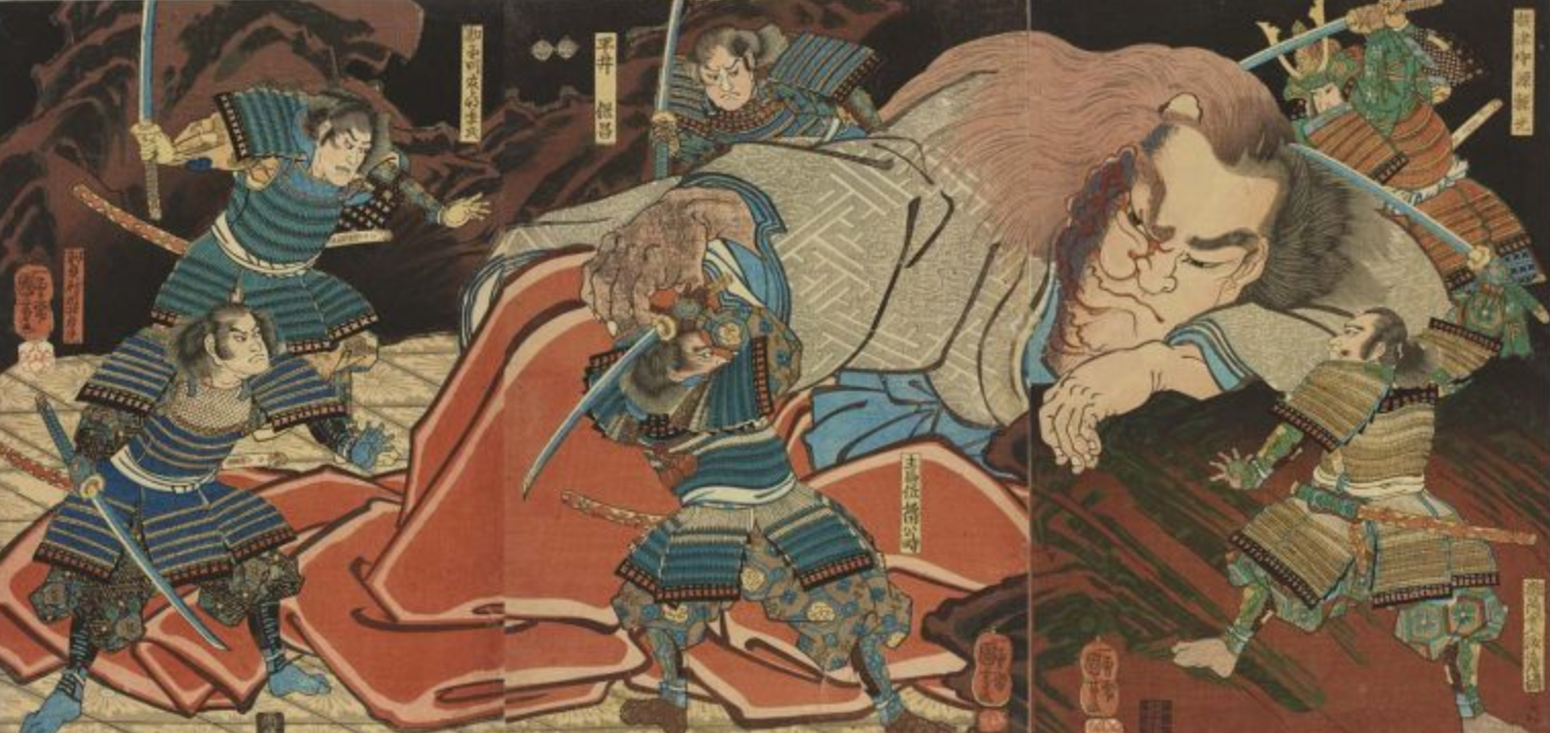This post continues the discussion that started here.
As I have mentioned before, there was in the late 1980s an attempt to produce a pseudo-Japanese supplement for WFRP. This was Tetsubo. Unlike other abandoned WFRP projects from that time, a draft of Tetsubo was for a time made publicly available. The draft is incomplete, but fascinating, nonetheless.
WORLD
One of the odd features of Tetsubo is that it is not, after all, a guide to Nippon. It sets out to describe instead the realm of Yamato. This was a curious design decision. The name of Warhammer‘s Japanese analogue had been firmly established as Nippon. Yamato may have sounded slightly more exotic (it is an ancient name for Honshu, Japan’s largest island), but it did not belong in the Warhammer world. The name had, in fact, appeared in Dave Morris’ Dragon Warriors game.
Amending the name, however, would have been a simple correction. A bigger defect was the lack of a detailed description of Yamato. This is, no doubt, one of several gaps that would have been filled had Tetsubo been published. But in the available Tetsubo draft, it makes it difficult to assess what the setting would have been like. It is as if WFRP1 had omitted the World Guide chapter: there are scattered hints as to the character of the setting, but they are vague and undifferentiated without a more thorough description of its lands and peoples.
BESTIARY
The best indication of what Yamato would have looked like can be found in the bestiary. This contains a familiar collection of fantastic oriental creatures. It is here that we can see some of the ways in which Yamato departs from the Warhammer setting.
Goblinoids are a cornerstone of the Warhammer world. They are also one of the few races mentioned as inhabiting Nippon. Yet they appear nowhere in Tetsubo‘s bestiary. It is a remarkable omission, though again one which could have been easily corrected.
Another Warhammer staple, the creature of Chaos, is present, with oriental versions of familiar creatures like beastmen alongside new ones like samebito (sharkman). However, creatures of Chaos are few in number and outnumbered by the traditional creatures of Asian myth.

Moreover, creatures of Chaos are kept out of Yamato by “the mighty barrier-spells of the Asahikawa shrine” and are confined to Shompo, the “Chaos-infested island to the north of Yamato”. Shompo’s “barren, wind-blasted soil” is ruled by Ranriu the Dragon Prince, who “dreams of taking Yamato … and re-establishing his Unholy Court at Koto”. The segregation of the forces of Chaos and their unification under a single leader creates a different feel from that of WFRP1‘s Old World. Ranriu appears to be a villain in a more traditional fantasy mould, one in a long line running from Sauron to the Night King. Chaos is more enemy without than enemy within.
One of the most difficult aspects of Tetsubo‘s bestiary is its deliberately vague zoology: “names given to various supernatural types can be imprecise and interchangeable”. This is at odds with the almost Aristotelian approach Warhammer (and other fantasy games) took to categorisation. For example, Tetsubo describes oni as “demons or ogres”; WFRP1 places demons and ogres in entirely different categories of creature.
The result is that Yamato does not feel as though it shares the same ecology as the Old World. This is particularly notable in the cases of the many malevolent spirits described in Tetsubo. It is never clear, for example, exactly what rokuro-kubi, mujina and yuki-onna are. Their origins and natures are mysterious. They have a fairytale quality, unlike the naturalism of most Warhammer creatures.
RELIGION
Tetsubo does contain a detailed account of Yamato’s religion. Yet it again ignores what had already been described. There are no traces of the Orange Simca or Vimto (though that might not be a bad thing!). Instead we have Shinto and a variant of Buddhism called Bukyo.
MAGIC
Tetsubo contains rules for magic use by Shugenja and Ninja. (Rules for Maboroshi and Taoist Mages are promised, but missing, in the draft.) Custom spell lists are provided, though they for the most part repeat effects in the WFRP1 rulebook. Overall, the magic system is, like the system for the Old World, a little bland. More could perhaps have been made of Chinese elementalism (as in Bushido). It is nonetheless perfectly functional.
CHARACTERS
There is a wealth of detail in the character section. There are a large number of new careers. Although many are little more than renamed careers from the Old World, there are also several that are genuinely distinctive. They go beyond the conventional classes of samurai, ninja, etc, and include, for example, Sumitori, Kago Bearer and Kabuki Actor. There is also a great deal on skills. The skills and careers are obviously incomplete, but of high quality, and could have formed an excellent system for Nipponese characters.
Less successful are the new races: shojo, shikome, and kitsune. It is made clear that such races can only operate on the fringes of the dominant human society, and their use creates a problem “the GM must give some thought to”. Given these problems, and a lack of solutions offered, it would seem better to omit the new PC races altogether.
Tetsubo also adds two new characteristics: Honour (inevitably) and Karma. There is insufficient guidance on their use, but that is probably attributable to Tetsubo‘s incompletion.
There is a brief discussion of Old Worlder PCs in Yamato (termed “gajin”, which was probably acceptable in the 1980s, but less so now). More could have been made of this, to link with the existing Old World setting. The historic example of William Adams (and fictitious one of John Blackthorne in Shogun) provided a template for such an approach.
COMBAT
Tetsubo meets well the expectation that players will have access to a wide range of exotic new weapons in Yamato: nunchaku, shuriken, kusarigama, etc. Unarmed combat is much less well covered and surely one of the omissions due to the incompletion of the draft that was made public.

OVERALL
I have previously said that Tetsubo “feels like a Japanese-inspired RPG that just happened to use the WFRP ruleset”. It does contain some concessions to the Warhammer background, but they are few in number. I still feel my original comment is a fair summary of Tetsubo‘s character.
However, all the Nippon material that had appeared in Warhammer before Tetsubo could be described in the same terms. Nippon never had a distinctive Warhammer feel and it seems somewhat unfair to single out Tetsubo in this regard.
Moreover, I believe Tetsubo required only modest changes to bring it more in line with the Warhammer world. This is something I will discuss in the next post.
See also my interview with Dave Morris on Tetsubo.
Title art by Hasegawa Sadanobu I. Internal art by Utagawa Kuniyoshi.
The “enemy without” approach to Chaos makes sense in the context of Japan’s history of closing itself off from the outside world, although I suspect it’s probably a stretch to say that it’s deliberate.
LikeLike
You make a good point. Of course, the enemy without has also been part of the Warhammer background since the very early days. But nowhere before was Chaos quite so clearly excluded. Given that Nippon was already significantly removed from the existing Warhammer background, it feels to me like a difference too far.
LikeLike
I have to say that Tetsubo doesn’t grab my interest very much at all. Its sounds like it was intended to be a bit more respectful and authentic. I’m far more interested in the cheesy clichés and bad puns of early editions of WFB, simply because they’re silly and fun. In the same way I want my Lustria full of frogmen, Amazons and fur-clad Norsemen messing about in Skeggi, I want my Cathay and Nippon full of ninja, Vimto monks, hopping vampires and a smaller version of Godzilla.
LikeLike
I’m not sure Tetsubo knew what it wanted to be. You could probably use it to run a “cheesy-cliché” game, but you’re right it does seem to lack some of early Warhammer’s silliness and sense of fun.
LikeLike
Some of the omissions you mention, such as the world background, aren’t because Dave and Jamie didn’t complete the manuscript for publication (they did) but that the PDF available on the Fabled Lands site is only about three-quarters of the whole book. There’s currently talk of reviving it with a new system, though those who are looking for a cheesy take on medieval Japan are likely to be disappointed.
LikeLike